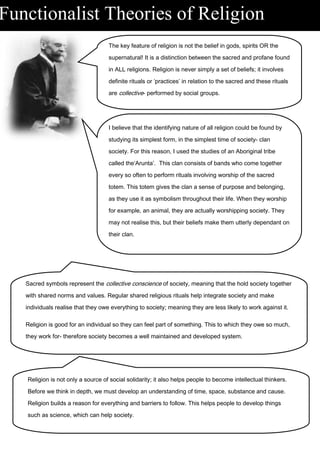
Functionalism: Religion as Social Integration
- 1. Functionalist Theories of Religion The key feature of religion is not the belief in gods, spirits OR the supernatural! It is a distinction between the sacred and profane found in ALL religions. Religion is never simply a set of beliefs; it involves definite rituals or ‘practices’ in relation to the sacred and these rituals are collective- performed by social groups. I believe that the identifying nature of all religion could be found by studying its simplest form, in the simplest time of society- clan society. For this reason, I used the studies of an Aboriginal tribe called the‘Arunta’. This clan consists of bands who come together every so often to perform rituals involving worship of the sacred totem. This totem gives the clan a sense of purpose and belonging, as they use it as symbolism throughout their life. When they worship for example, an animal, they are actually worshipping society. They may not realise this, but their beliefs make them utterly dependant on their clan. Sacred symbols represent the collective conscience of society, meaning that the hold society together with shared norms and values. Regular shared religious rituals help integrate society and make individuals realise that they owe everything to society; meaning they are less likely to work against it. Religion is good for an individual so they can feel part of something. This to which they owe so much, they work for- therefore society becomes a well maintained and developed system. Religion is not only a source of social solidarity; it also helps people to become intellectual thinkers. Before we think in depth, we must develop an understanding of time, space, substance and cause. Religion builds a reason for everything and barriers to follow. This helps people to develop things such as science, which can help society.
